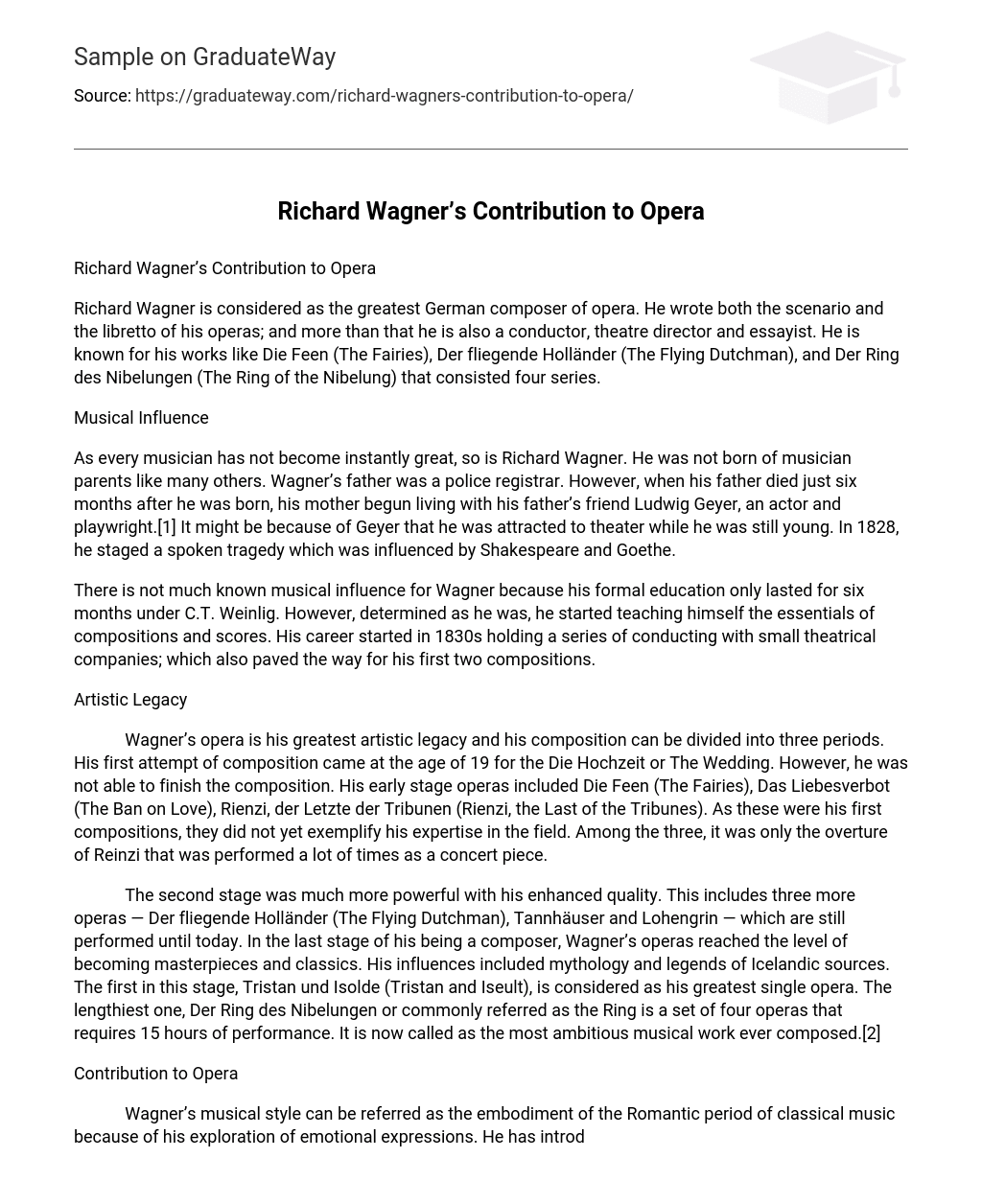Richard Wagner is considered as the greatest German composer of opera. He wrote both the scenario and the libretto of his operas; and more than that he is also a conductor, theatre director and essayist. He is known for his works like Die Feen (The Fairies), Der fliegende Holländer (The Flying Dutchman), and Der Ring des Nibelungen (The Ring of the Nibelung) that consisted four series.
Musical Influence
As every musician has not become instantly great, so is Richard Wagner. He was not born of musician parents like many others. Wagner’s father was a police registrar. However, when his father died just six months after he was born, his mother begun living with his father’s friend Ludwig Geyer, an actor and playwright.[1] It might be because of Geyer that he was attracted to theater while he was still young. In 1828, he staged a spoken tragedy which was influenced by Shakespeare and Goethe.
There is not much known musical influence for Wagner because his formal education only lasted for six months under C.T. Weinlig. However, determined as he was, he started teaching himself the essentials of compositions and scores. His career started in 1830s holding a series of conducting with small theatrical companies; which also paved the way for his first two compositions.
Artistic Legacy
Wagner’s opera is his greatest artistic legacy and his composition can be divided into three periods. His first attempt of composition came at the age of 19 for the Die Hochzeit or The Wedding. However, he was not able to finish the composition. His early stage operas included Die Feen (The Fairies), Das Liebesverbot (The Ban on Love), Rienzi, der Letzte der Tribunen (Rienzi, the Last of the Tribunes). As these were his first compositions, they did not yet exemplify his expertise in the field. Among the three, it was only the overture of Reinzi that was performed a lot of times as a concert piece.
The second stage was much more powerful with his enhanced quality. This includes three more operas — Der fliegende Holländer (The Flying Dutchman), Tannhäuser and Lohengrin — which are still performed until today. In the last stage of his being a composer, Wagner’s operas reached the level of becoming masterpieces and classics. His influences included mythology and legends of Icelandic sources. The first in this stage, Tristan und Isolde (Tristan and Iseult), is considered as his greatest single opera. The lengthiest one, Der Ring des Nibelungen or commonly referred as the Ring is a set of four operas that requires 15 hours of performance. It is now called as the most ambitious musical work ever composed.[2]
Contribution to Opera
Wagner’s musical style can be referred as the embodiment of the Romantic period of classical music because of his exploration of emotional expressions. He has introduced extreme chromaticism, for example is his composition Tristan und Isolde, he explored new tonal system that paved way to atonality in the twentieth century. Modern classical music traces back some chords to that opera which has come to be known as the Tristan chord. Claude Debussy and Arnold Schoenberg, in particular are two modern musicians that has been influenced by the Tristan’s tonal and atonal revolution. On the other hand, the Italian form of operatic realism or verismo is also considered as an influence of Wagner’s musical form. To other opera musicians, “there is only Beethoven and Wagner.”
Being a conductor of his own compositions, Wagner also contributed major principles and practice of conducting. He proposed that conducting is not simply a mechanism to achieve unison in orchestra but a way where musical form could be reinterpreted. Many European conductors followed the tradition of Wagner. Other than that, he was also artistic in terms of the sceneries during the performance of operas. He was the one who started the art of dimming lights during dramatic performances and concealing the orchestra from the audience.
Wagner regarded himself as the “most German of men” and “the German spirit.”[3] This is so because of his influence not only in music and his other literary compositions but also in understanding of German culture and history. His name does not only appear in the field of music rather in almost all trends in history of the nineteenth and twentieth century Germany. He was also the first musician to use his stature as a means of influencing, entrancing, intoxicating and conquering.[4]
[1] http://www.island-of-freedom.com/WAGNER.HTM
[2] Magee, Bryan (2001). The Tristan Chord: Wagner and Philosophy. Clearwater, Fla: Metropolitan Books.
[3] http://users.utu.fi/hansalmi/spirit.html
[4] http://users.utu.fi/hansalmi/bio.html





